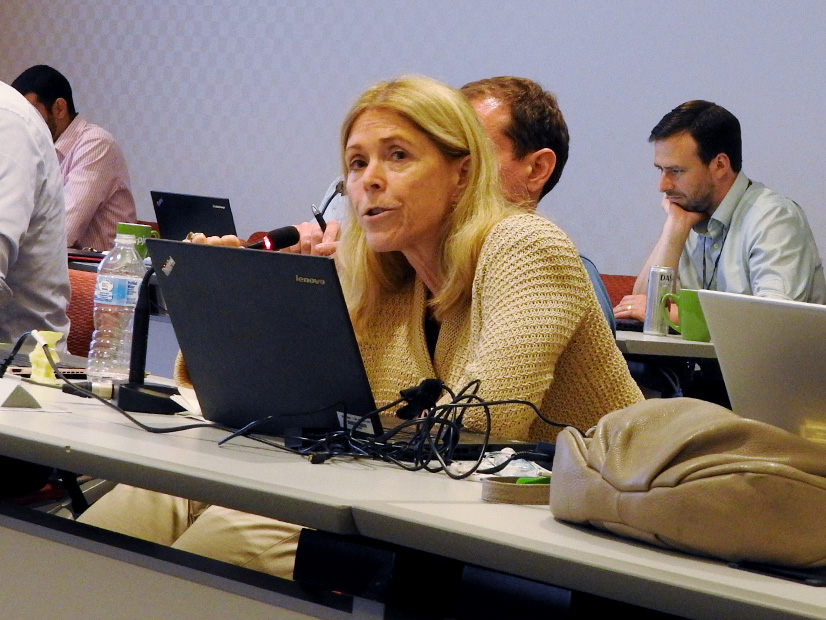Renewable Dispatch
VALLEY FORGE, Pa. —
The PJM Markets and Reliability Committee on Wednesday endorsed a new renewable dispatch structure proposed by the RTO and the Independent Market Monitor.
The endorsement directs staff to return to the committee with revised tariff and manual changes incorporating the market changes. PJM’s Darrell Frogg said the structure would provide better data to allow dispatchers to anticipate the output of renewables and increase transparency on performance and forecast accuracy through regular reviews with stakeholders. (See “PJM, Monitor Present Renewable Dispatch Proposal,” PJM MRC/MC Briefs: March. 22, 2023.)
The construct would replace the use of curtailment flags sent to generators through the Inter-Control Center Communications Protocol (ICCP) with economic basepoints. Generators would be directed to follow those basepoints regardless of curtailments because of the potential for inadvertent curtailments.
Renewable resources would be required to offer into the day-ahead market unless they receive approval for an exception for a physical constraint from PJM and the Monitor. Their offers would be based on forecasts of both weather and equipment availability produced by either the market seller or PJM.
Generators would be required to update their critical parameters in real-time security-constrained economic dispatch (SCED) every five minutes and on an hourly basis for parameters in intermediate-term SCED cases.
The lost opportunity cost structure currently available for wind resources would be extended to solar, making them available for payments when they follow dispatch through SCED basepoints.
Paul Sotkiewicz, president of E-Cubed Policy Associates, said the proposal appears to leave a lot undefined at this point. Frogg agreed, but he added that those details will be filled in as tariff and manual language is developed.
Capacity Performance Penalties
Stakeholders discussed three proposals to change when generators can be assigned Capacity Performance (CP) penalties and how they are calculated. Proponents described the changes as an effort to put market changes in place while stakeholders consider longer-term proposals being drafted through the Critical Issue Fast Path (CIFP) process. (See PJM Presents More Detail on CIFP Proposal.)
All three would shift the charge rate from being based on the net cost of new entry to the Base Residual Auction (BRA) clearing price for that delivery year. If the alternative calculation was applied to the 2023/24 delivery year, it would result in a $394/MWh penalty, versus the status quo of $3,177/MWh.
The proposals differ in both the stop-loss limit (SLL) and the trigger for the performance assessment intervals (PAIs) that define when a generator can be assigned penalties or bonuses based on how they match up against their obligation.
LS Power and the Monitor are proposing a limit set at twice the BRA clearing price, while American Municipal Power used a lower SLL at 1.5 times the clearing price.
For the PAI trigger, LS Power and AMP suggested mirroring the provisions in PJM’s CIFP proposal, which would only allow PAIs when there is a real-time reserve shortage and declaration of emergency procedures more severe than pre-emergency demand response. Stakeholders said that DR should be utilized like any other capacity resource, and its dispatch shouldn’t subject other resources to penalties.
“It puts some discipline around when PAIs are called; it gives you some indication about when we’re getting close to when a PAI may be called,” LS Power’s Tom Hoatson said.
The Monitor’s proposal would predicate the implementation of a PAI on a shortage of primary reserves and a PJM declaration of a regional emergency.
LS Power’s Marji Philips said that FERC’s 2021 order on PJM’s market seller offer cap caused generation owners to lose the ability to adequately represent the risks they take on by participating in the capacity market. By reducing CP penalties, she said the proposal would de-risk the capacity market.
Vitol’s Jason Barker said the purpose of the penalties is to incent behavior, and reducing that wouldn’t lead generators to make the investments lessening the likelihood of events similar to the December 2022 winter storm.
“From our perspective there has to be a meaningful penalty,” he said.
PJM’s Adam Keech said the RTO is comfortable with the proposed changes to the PAI trigger, but it has concerns with reducing penalties without addressing the other side of the ledger: winterization and other mandates that would require capacity resources to improve their ability to perform. He said that the high penalties were a tradeoff to limited hard rules, and the proposals would significantly decrease penalties without introducing other ways of ensuring performance.
The LS Power proposal was introduced to the committee as a quick fix, meaning that the issue charge, problem statement and solution could be voted on during the same meeting. Noting the hourslong discussion it generated on Wednesday, some stakeholders questioned if it met the criteria of an issue that could be addressed with minimal stakeholder input.
Special meetings of the MRC and Members Committee have been scheduled for May 4 and 11, respectively, to further discuss the issue and potentially vote on endorsement.
Stakeholders Endorse Manual 11 Changes
Stakeholders endorsed revisions to Manual 11, which pertains to energy and ancillary services market operations, through the biennial cover-to-cover review of the document. Stakeholders deferred a vote on the changes during last month’s MRC meeting to allow more time to review amendments proposed in an effort to align the language with PJM’s other governing documents. (See “Other Stakeholder Discussions,” PJM MRC/MC Briefs: March. 22, 2023.)
The revisions presented at the second read on March 22 were revised to remove changes to the operating parameter definitions affecting the minimum run time for combined cycle units. The excised language is anticipated to return after being reviewed by the Governing Document Enhancement & Clarification Subcommittee.


